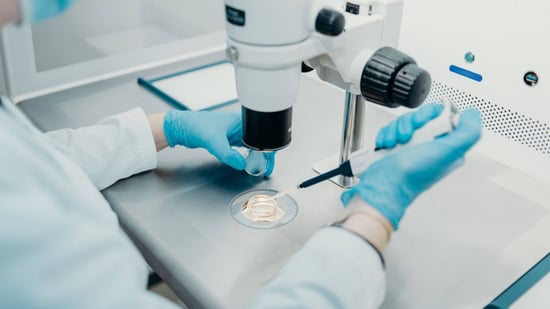Day 3 vs. Day 5 Embryos: The Benefits of Transferring Blastocysts
July 15th, 2024 | 5 min. read

Ask Monica is a Q&A video series hosted by Nurse Practitioner Monica Moore.
In this article:
What is a blastocyst?
Exploring the amazing science behind IVF, the phases of embryo development, and why we wait five days for embryos to grow before doing embryo transfers at the blastocyst stage.
Monica Moore:
Hi everyone, Monica Moore here. Today's edition of Ask Monica is all about the blastocyst.
What exactly is a blastocyst? And why do we perform embryo transfers at this specific stage of development?
A blastocyst is a five or six-day-old embryo that has grown to the stage at which implantation takes place. Blastocysts usually consist of the following:
- Trophoblast cells, which become the early placenta
- Inner cell mass, which becomes the baby
- A fluid-filled cavity called a blastocele
The blastocyst stage is when an embryo typically implants into the uterus. In an IVF cycle, when we transfer this 5-day old embryo, it usually floats around for a couple of hours or even up to a day or two, then finds a cozy spot and implants in the uterine wall.
Day 3 vs. Day 5 Embryo Transfer
By the third day of the embryo development process, the embryo consists of somewhere between 6-10 cells. We used to transfer these Day 3 embryos, because science hadn't yet perfected the art of growing embryos all the way to the blastocyst stage (Day 5).
Now that assisted reproductive technology has advanced, we're able to consistently grow embryos to Day 5 in the embryology laboratory. There are three main reasons to perform embryo transfers at the blastocyst stage of development (Day 5, instead of Day 3).
Benefit #1: The Embryo is More Developed
When we look at a Day 3 embryo, there are only a couple of cells visible.
We used to look under the microscope and decide (based on these couple of cells) what looked "good" to us - essentially, we would make an educated guess about whether we thought it would end up creating a baby or a clinical pregnancy. But we have very little information when we're looking at an embryo like this.
When we look at Day 5 embryos (blastocysts) we can actually assign specific "grades" based off of how we think the trophoblast cells look. These are usually letter grades, where we take into account how the inner cell mass looks, how big the blastocele cavity is, or if these are all compressed. Embryologists then assign each embryo a grade.
In short, looking at a blastocyst allows us to see the embryo at the stage closest to when implantation takes place. This helps us select the best embryos available for transfer, which have the best chance of success.
Benefit #2: We Can Monitor Attrition
Part of the biological process of embryo development is called attrition, and this refers to the fact that there are naturally going to be a number of embryos that stop progressing between Day 3 and Day 5. While this can be hard to hear, this is just due to normal human physiology.
During an IVF cycle, we start out by retrieving many eggs, then seeing which of those eggs are mature. Any mature eggs are fertilized in the embryology lab and some of those fertilized eggs go on to become embryos.
But during all of those stages, from early embryo to blastocyst, we lose a lot of them, and that's just normal within the body. That's just what the body does in order to leave us with embryos that are (hopefully) going to create a healthy baby.
We want that attrition process to take place inside the lab, as opposed to inside the body, so we can monitor the remaining blastocysts carefully each day. This isn't a perfect science, but in theory, the body will want to "keep" these embryos because they made it to blastocyst.
Benefit #3: Blastocysts Are More Stable
Finally, we're able to gather more more information on Day 5 embryos because they now have hundreds of cells, instead of just a few. At this stage, they are referred to as what's called a differentiated embryo, which has distinct, different parts. However, they haven't developed into specific parts (the baby and the placenta) yet, so we can gather more information on the blastocyst.
When we do the embryo biopsy for preimplantation genetic testing (PGT), we sample a few of these outside (trophoblast) cells. These cells are biopsied and sent off to a specialized genetics lab to assess their chromosomal makeup.
We don't want to take one cell out of an eight-celled embryo, as this could be detrimental or damaging to the embryo. However, taking a few of the placental cells (out of hundreds) and then not touching or damaging the inner cell mass, that's the safest option. There have been a lot of studies done on this over the years, so we feel really comfortable with that.
Hope that's helpful. As always, ask us any questions or send us any of your concerns. Thanks again. See you soon.
Have a question about fertility?
Submit it here and we'll answer it in a future episode of Ask Monica!
Monica Moore is a board-certified Advanced Practice Nurse Practitioner, nurse educator and health coach who has been caring for patients at Illume Fertility for over 20 years. She is also the founder and lead educator at Fertile Health, LLC. Monica is passionate about taking care of the whole patient, believing in the importance of integrating comprehensive care. She has a special interest in PCOS and combating weight bias with education and advocacy.
